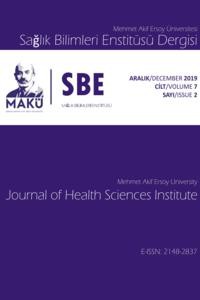Abstract
References
- Açıkgöz, H., Türer. İ., 2014. A Novel Microwave Coaxial Slot Antenna for Liver Tumor Ablation. Advanced Electromagnetics, vol. 3, 2014.
- Bertram, J.M., Yang, D., Converse, M.C., Webster, J.G., Mahvi, D.M., 2006. A Review of Coaxial-Based Interstitial Antennas for Hepatic Microwave Ablation. Critical Reviews in Biomedical Engineering 2006; 34(3):187–213.
- Chiang, J., Hynes, K., Brace. CL., 2012. Flow-Dependent Vascular Heat Transfer during Microwave Thermal Ablation. ConfProc IEEE Eng Med Biol Soc. 2012 August; 2012: 5582–5585. doi:10.1109/EMBC.2012.6347259.
- Hinshaw, J.L., Lubner, M.G., Ziemlewicz, T.J., Lee, F.T., Jr, Brace, C.L., 2014. Percutaneous tumor ablation tools: Microwave, radiofrequency, or cryoablation—What should you use and why? 2014; 35:1344–1362 10.1148/rg.345140054.
- Kaur, S., Maini, S., 2007. Ablation Options For Treatment of HCC - MWA and RFA. International Journal of Emerging Technologies in Computational and Applied Sciences (IJETCAS) 2279-0047; 2007:2279-0055.
- Lin. J.C., Wang, Y.J.; 1996. “The cap-choke catheter antenna for microwave ablation treatment” IEEE Trans Biomed Eng. 1996;43(6):657-60.
- Shock, S.A., Meredith, K., Warner, T.F., Sampson, L.A., Wright, A.S., Winter III, T.C., Mahvi, D.M., Fine, J.P., Lee, F.T., 2004. Microwave Ablation with Loop Antenna: In Vivo Porcine Liver Model. Radiology 10.1148/radiol.2311021342. 2004; 231:143–149.
- Simon, C.J., Dupuy, D.E., Mayo-Smith, W.W., 2005. Microwave Ablation: Principles and Applications. Radio Graphics 2005; 25: S69–S83.10.1148/rg.25si055501.
- Yu, N.C., Lu, D.S.K., Raman, S.S., Dupuy, D.E., Simon, C.J., Lassman, C., Iaswad, B., Ianniti, D., Busuttil. R.W., 2006. Hepatocellular Carcinoma: microwave ablation with multiple straight and loop antenna clusters pilot comparison with pathologic findings. 10.1148/radiol.2383041592Radiology 2006; 239:269–275.
Abstract
This work compares the effect of a
monopole antenna without cooling unit on a biological tissue and a monopole
antenna with cooling unit. Computer simulation was done using a computer software
named COMSOL MultiphysicsTM, input power was varied from 10W to
120W, with an interval of 10W, at different times, from 60s to 120s at an
interval of 60s. It was observed that the diameter of
the lowest power (20W) decreased by -17.2% at 5mins, the length decreased by
-32.9% and aspect ratio for the two antennas increased by 23.40%. For medium
power (60W), at 5mins, the diameter decreased by -9.89%, length decreased by
-37.9%, and aspect ratio decreased by 45.24%. The p-value obtained from diameter
for low power showed no significant difference for ablation without water cool
(p > 0.005), but showed significant difference with water cool (p <
0.005), diameter for medium power showed no significant difference, p >
0.005 in both simulations, there was no statistically
significant difference in the diameter for high power (110W and 120W) for both
simulations, p-value > 0.005. The
result showed that inclusion of cooling unit reduced backward heating of
microwave antenna, ablation length, and ablation diameter of simulated tissue.
References
- Açıkgöz, H., Türer. İ., 2014. A Novel Microwave Coaxial Slot Antenna for Liver Tumor Ablation. Advanced Electromagnetics, vol. 3, 2014.
- Bertram, J.M., Yang, D., Converse, M.C., Webster, J.G., Mahvi, D.M., 2006. A Review of Coaxial-Based Interstitial Antennas for Hepatic Microwave Ablation. Critical Reviews in Biomedical Engineering 2006; 34(3):187–213.
- Chiang, J., Hynes, K., Brace. CL., 2012. Flow-Dependent Vascular Heat Transfer during Microwave Thermal Ablation. ConfProc IEEE Eng Med Biol Soc. 2012 August; 2012: 5582–5585. doi:10.1109/EMBC.2012.6347259.
- Hinshaw, J.L., Lubner, M.G., Ziemlewicz, T.J., Lee, F.T., Jr, Brace, C.L., 2014. Percutaneous tumor ablation tools: Microwave, radiofrequency, or cryoablation—What should you use and why? 2014; 35:1344–1362 10.1148/rg.345140054.
- Kaur, S., Maini, S., 2007. Ablation Options For Treatment of HCC - MWA and RFA. International Journal of Emerging Technologies in Computational and Applied Sciences (IJETCAS) 2279-0047; 2007:2279-0055.
- Lin. J.C., Wang, Y.J.; 1996. “The cap-choke catheter antenna for microwave ablation treatment” IEEE Trans Biomed Eng. 1996;43(6):657-60.
- Shock, S.A., Meredith, K., Warner, T.F., Sampson, L.A., Wright, A.S., Winter III, T.C., Mahvi, D.M., Fine, J.P., Lee, F.T., 2004. Microwave Ablation with Loop Antenna: In Vivo Porcine Liver Model. Radiology 10.1148/radiol.2311021342. 2004; 231:143–149.
- Simon, C.J., Dupuy, D.E., Mayo-Smith, W.W., 2005. Microwave Ablation: Principles and Applications. Radio Graphics 2005; 25: S69–S83.10.1148/rg.25si055501.
- Yu, N.C., Lu, D.S.K., Raman, S.S., Dupuy, D.E., Simon, C.J., Lassman, C., Iaswad, B., Ianniti, D., Busuttil. R.W., 2006. Hepatocellular Carcinoma: microwave ablation with multiple straight and loop antenna clusters pilot comparison with pathologic findings. 10.1148/radiol.2383041592Radiology 2006; 239:269–275.
Details
| Primary Language | English |
|---|---|
| Subjects | Health Care Administration |
| Journal Section | Research Article |
| Authors | |
| Publication Date | December 30, 2019 |
| Submission Date | July 10, 2019 |
| Published in Issue | Year 2019 Volume: 7 Issue: 2 |
Cite
Cited By
Effect of the antenna slot numbers and position on the performance of microwave ablation
Medicine in Novel Technology and Devices
https://doi.org/10.1016/j.medntd.2023.100271

This work is licensed under a Creative Commons Attribution 4.0 International License.


